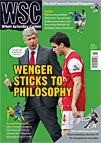 It’s been a funny season for the A-League with financial chaos tempered by a record-breaking climax. Robert Forsaith explains
It’s been a funny season for the A-League with financial chaos tempered by a record-breaking climax. Robert Forsaith explains
“What a fantastic game, what a fantastic spectacle for the A-League. The game has been crying out for something positive this year.” That was the verdict on the final match of the season from Graham Arnold, the coach whose side Central Coast had just been beaten in a penalty shootout.
The Brisbane Roar had claimed the Premiership (the top spot in the league table) with a few rounds to spare, but that counts for little in Australia. The sporting psyche is fixed on the grand final and so it is in football with the A-League finalists having to battle through three weeks of play-offs. These raise the ire of traditionalists, but apart from the A-League’s first season, every grand final to decide the championship has been between the top two in the regular season.
The Roar, hosts and hot favourites for the championship title after a season that included a record-breaking 27-match unbeaten streak, found themselves 2-0 down with four minutes of extra time left. Brisbane somehow pulled back two goals, the second of which came from the last move of the game. Goalkeeper Michael Theoklitos – who had one disastrous game for Norwich City in which he conceded seven – then steered his side to the title after a 4-2 win in the penalty shoot-out watched by a hysterical crowd of 50,168.
The next day Football Federation Australia (FFA) assumed control of the Roar after their owners relinquished the club’s licence, which they could no longer afford. The paradox summed up the 2010-11 A-League season. While the standard of football has never been better, off-field issues have been prevalent. Australia’s 2022 World Cup bid failed in humiliating fashion and football received the most negative press it has seen since the National Soccer League folded in 2004.
The local tabloids had a field day. The Daily Telegraph declared it “the greatest sporting scandal in the history of this country – a folly aimed purely at the gratification of a few egos that cost Australian taxpayers $45 million [£29m]”.
A-League attendances fell sharply after five years of growth. There were extenuating circumstances, but the smallest crowd in the competition’s history (1,003) was recorded in February. Gold Coast United led the way, with billionaire owner Clive Palmer limiting home crowds to 5,000 in a cost-cutting venture. United’s future is now in doubt with internationals Shane Smeltz, Jason Culina and Bruce Djite all sold off. Worth a reported $6.5 billion, Palmer is one of few owners who could comfortably exceed the salary cap, which has been an integral part of FFA’s plan for competitive balance. For 2010-11, each club had to assemble a squad worth less than $2.35m. However, teams can sign one “marquee” player, whose salary is exempt from this, such as Dwight Yorke and Robbie Fowler in previous years.
Gold Coast were one of two expansion sides for 2009-10. The other, North Queensland Fury, were dumped from the competition shortly before this year’s grand final; FFA, who recorded a loss of almost $6m in the last financial year, decided they could no longer continue to subsidise the debt-ridden club. Furious locals are decrying the Fury’s demise as the end of football in the region and questioning why the game’s governing body hasn’t been more lenient. However, most clubs have needed some form of FFA involvement to remain afloat ever since the competition was founded seven years ago. Botched expansion has been a source of frustration for many fans, the latest blow being the collapse of a planned Western Sydney franchise which went bust before joining the league.
While the season’s climax was preceded by headlines suggesting the A-League is in commercial meltdown, tickets sold faster than anyone had expected. It was the highest attendance for football in Brisbane, ahead of World Cup qualifiers that have featured headliners like Tim Cahill, Harry Kewell and Mark Schwarzer. Civic pride was also at play. The Suncorp Stadium was lashed during the January floods, with an aerial view of the submerged playing surface arguably one of the disaster’s defining images.
After a welter of positive press, everyone was talking football. Former Australian rules and rugby league players even decreed it to be one of the best sporting events in Australian history. The Roar drew an average home crowd of 11,200 last season so there were roughly 40,000 there who don’t watch the team on a regular basis. It’s only one market, but if the FFA strengthens its presence in Brisbane, the A-League will surely be a more sustainable competition.
From WSC 291 May 2011